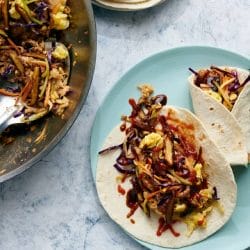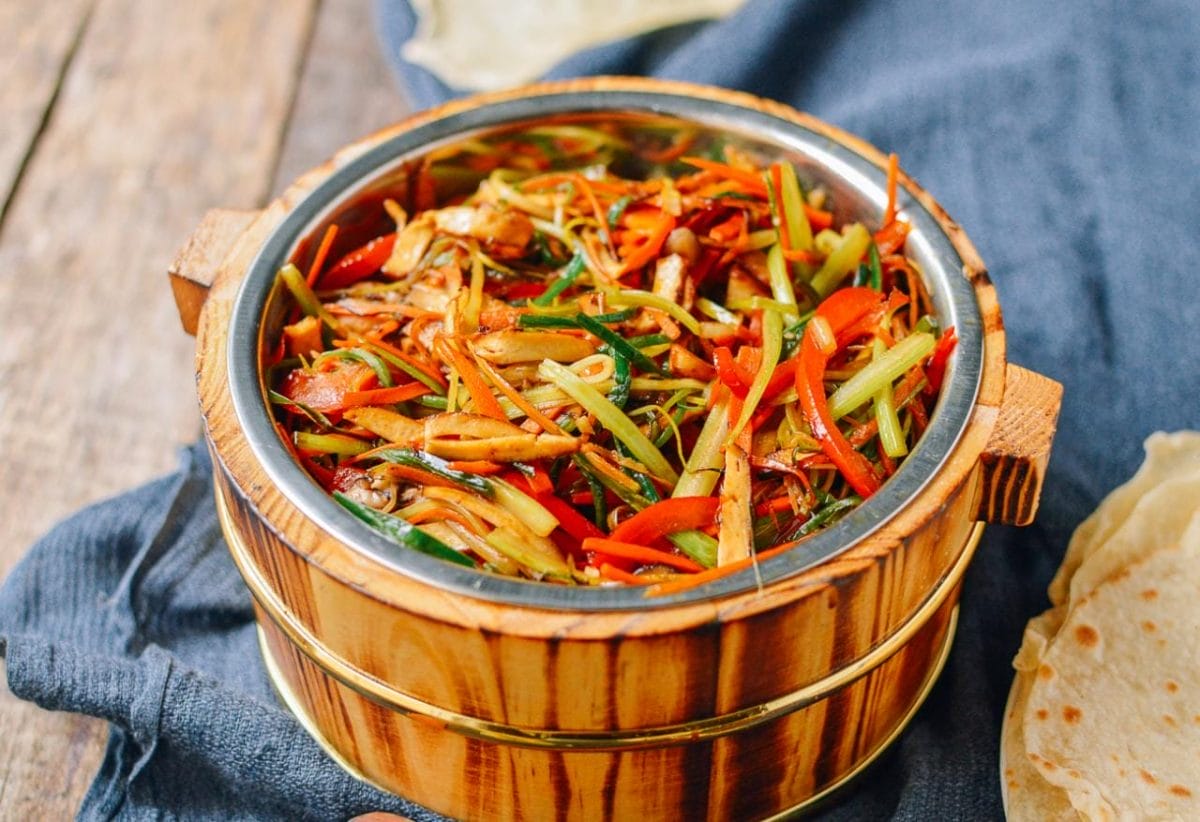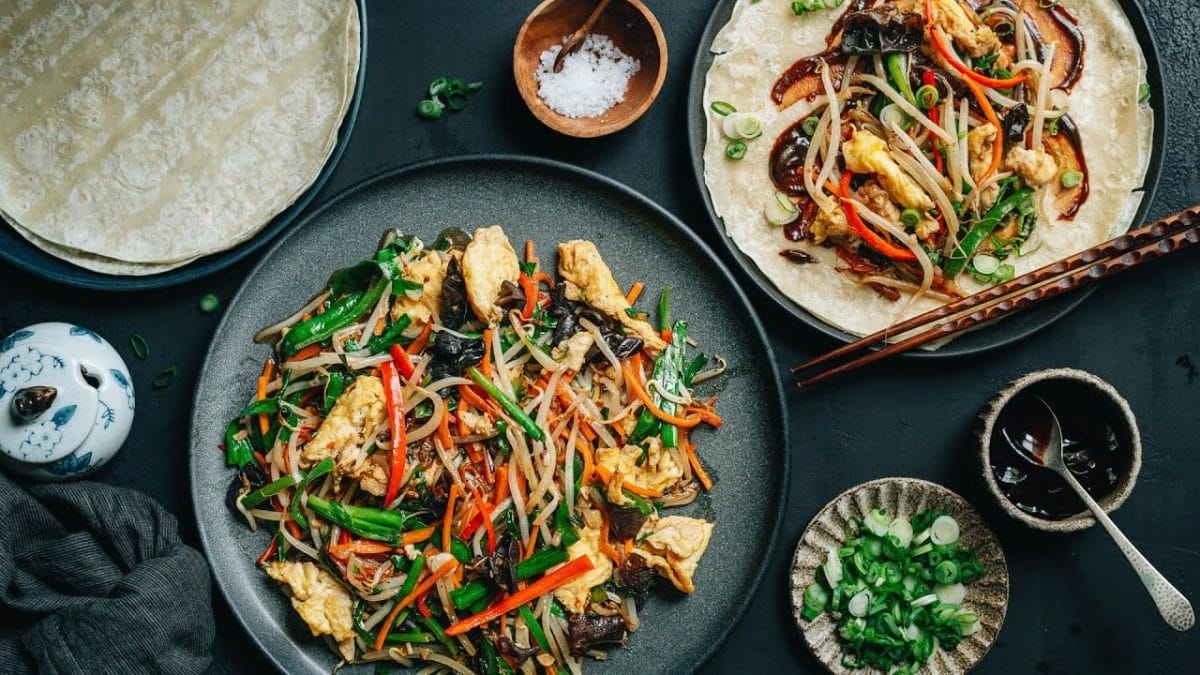Hello, dear reader! Today, I invite you to join me on a culinary adventure as we explore the wonders of a dish that has captured my heart and taste buds – the delightful Vegetarian Moo Shu.
Cooking Vegetarian Moo Shu is like conducting an orchestra. Each ingredient plays a crucial role, contributing its unique flavor and texture to create a harmonious dish.
Since we’re skipping the recipe part, let’s delve into some cooking tips that can take your Vegetarian Moo Shu from good to great. These are insights I’ve gathered over years of culinary adventures, and I’m excited to share them with you.


Chinese Vegetarian Moo Shu
Equipment
- 1 large non-stick pan
- 1 serving dish
Ingredients
- 3 teaspoons toasted sesame oil divided
- 4 large eggs lightly beaten
- 2 teaspoons ginger finely chopped
- 2 garlic cloves finely chopped
- 1 12- ounce bag shredded mixed vegetables
- 1 cup mung bean sprouts
- 1 cup mushrooms sliced
- 1 bunch scallions chopped, divided
- 1 tablespoon soy sauce
- 1 tablespoon rice vinegar
- 2 tablespoons hoisin sauce
Instructions
- Heat a large non-stick pan over medium heat. Add oil and wait until hot. Slowly stir in eggs and cook for about 2 minutes or until set. Transfer to a plate.
- Clean pan and add remaining oil. Heat over medium heat. Sauté ginger and garlic for about a minute or until tender and aromatic. Toss in shredded vegetables, mushrooms, bean sprouts, half of the scallions, soy sauce, and vinegar. Stir until combined. Cover, then cook for about 3 minutes or until vegetables are soft. Stir a few times while cooking. Take off cover and add scrambled eggs and hoisin sauce. Stir and break up eggs for about a minute or until thoroughly heated. Add the rest of the scallions and stir to combine.
- Transfer to a serving dish. Serve warm.
Video
Notes
Cooking Tips

Creating the perfect Vegetarian Moo Shu is a culinary journey, a dance of flavors and textures that come together to create a symphony on your palate. Here are some tips that I’ve gathered over the years, each one a stepping stone towards mastering this delightful dish.
- Choosing the Right Vegetables: The soul of Vegetarian Moo Shu lies in its vegetables. Traditional Moo Shu uses a variety of vegetables including cabbage, mushrooms, and carrots. Their different textures and flavors contribute to the overall complexity of the dish. Feel free to experiment with other vegetables like bell peppers or zucchini to add your own twist.
- Preparing the Pancakes: The pancakes in Moo Shu are thin and delicate. They should be lightly toasted on a pan until they are warm and pliable. This ensures they can be easily folded around the filling without breaking.
- Balancing the Flavors: Vegetarian Moo Shu is all about balance. The sweetness of the hoisin sauce, the savoriness of the soy sauce, and the freshness of the vegetables should all complement each other without overpowering.
- Mastering the Stir-Fry Technique: Stir-frying is a quick cooking method that requires constant stirring to ensure even cooking and prevent burning. Make sure your pan is hot enough before adding the ingredients, and keep them moving around the pan for best results.
- The Order of Ingredients: When stir-frying, always add the ingredients that take longer to cook first. This usually means the harder vegetables go in before the softer ones. This way, everything finishes cooking at the same time, and nothing ends up over or undercooked.
- Sauce Matters: The sauce is what brings everything together. It should be a balance of sweet, salty, and umami flavors. Hoisin sauce, soy sauce, and a touch of sugar usually do the trick. Don’t forget a dash of sesame oil for that extra depth of flavor.
- Freshness is Key: Use fresh ingredients whenever possible. Fresh vegetables retain their crunch and color better than frozen ones, and they have a superior taste.
- Garnish Generously: Never underestimate the power of a good garnish. A sprinkle of sesame seeds or a handful of chopped scallions can add an extra layer of flavor and make your Vegetarian Moo Shu look restaurant-worthy.
- Experiment with Proteins: While traditional Moo Shu often includes meat, there are plenty of vegetarian protein options you can use. Tofu, tempeh, or seitan can all be great additions to your Vegetarian Moo Shu.
- Don’t Overcrowd the Pan: When stir-frying, it’s important not to overcrowd the pan. Too many ingredients can lower the temperature of the pan and cause the food to steam instead of fry. If necessary, cook in batches to maintain the high heat needed for a good stir-fry.
Remember, cooking is as much about the journey as it is about the destination. So, take your time, experiment with these tips, and most importantly, have fun! After all, the best Vegetarian Moo Shu is the one made with love.
Serving Suggestion

Serving Vegetarian Moo Shu is not just about transferring the dish from the wok to the plate. It’s a culinary experience, an opportunity to showcase the harmony of flavors and textures that you’ve meticulously crafted. Here’s how I like to serve this delightful dish:
- Choose the Right Dish: A large, open dish or a shallow bowl works best for serving Vegetarian Moo Shu. The wide surface area allows the colorful ingredients to be spread out and displayed, making the dish as visually appealing as it is delicious.
- Presentation Matters: When transferring the Vegetarian Moo Shu to the serving dish, don’t just dump it in. Use tongs or a large fork and spoon to gently lift and place the filling, ensuring that the vegetables and protein are evenly distributed. This way, every serving will have a good mix of all the ingredients.
- Garnish Generously: Garnishing is the final touch that can elevate your Vegetarian Moo Shu from good to great. A sprinkle of toasted sesame seeds adds a nutty flavor and a subtle crunch, while freshly chopped scallions bring a pop of color and a burst of freshness.
- Serve with Pancakes: Vegetarian Moo Shu is traditionally served with thin pancakes. Warm them up before serving and place them on a separate plate. Encourage your guests to assemble their own Moo Shu for a fun, interactive dining experience.
- Accompaniments: While Vegetarian Moo Shu is a complete meal in itself, you can pair it with some hot and sour soup or steamed dumplings for a full-on Chinese feast. For those who like a bit of heat, a side of chili oil or Sriracha sauce can be provided.
- Set the Scene: Serving Vegetarian Moo Shu is also about creating an atmosphere. Set the table with some nice dinnerware, light some candles, play some soft music in the background. These little details can enhance the dining experience and make the meal even more enjoyable.
- Personal Touch: Lastly, add a personal touch to your serving. Maybe it’s a special serving dish passed down through generations, or a unique garnish that you love. This personal touch can make the meal even more special and memorable.
Remember, serving Vegetarian Moo Shu is an act of love. It’s about sharing a dish that you’ve put your heart and soul into. So, take your time, enjoy the process, and most importantly, savor the reactions of delight and satisfaction from your loved ones as they dig in.
FAQs about Vegetarian Moo Shu

Over the years, I’ve encountered several questions about Vegetarian Moo Shu. Here are some answers that might satisfy your curiosity:
Can Vegetarian Moo Shu be made gluten-free?
Absolutely! Just replace the traditional soy sauce with tamari or any other gluten-free soy sauce alternative.
Can I prepare Vegetarian Moo Shu in advance?
Yes, you can. However, I’d recommend making it fresh whenever possible as the flavors are more vibrant.
Can I use other types of vegetables for this dish?
Definitely! You can use any vegetables you like. Bell peppers, zucchini, and bok choy are some of my favorites.
What can I use instead of pancakes in Vegetarian Moo Shu?
If you don’t have pancakes, you can use tortillas or even lettuce wraps as alternatives.
Is Vegetarian Moo Shu spicy?
Not typically, but you can add some heat by including chili sauce or crushed red pepper flakes.
As I conclude this culinary tale, I find myself filled with a sense of contentment. Vegetarian Moo Shu, for me, is more than just a dish. It’s a canvas where I can express my creativity, a comfort food that never fails to lift my spirits, and a culinary adventure that always leaves me excited for more.
So, my dear reader, I invite you to embark on your own journey with Vegetarian Moo Shu. Trust me, it’s a ride worth taking.

